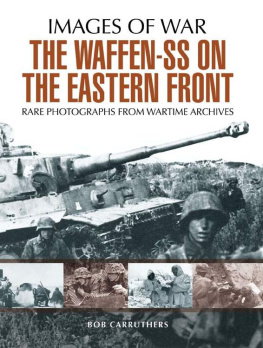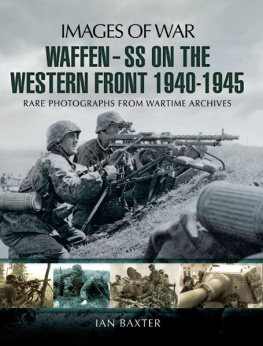
First published in Great Britain in 2014 by
PEN & SWORD MILITARY
An imprint of
Pen & Sword Books Ltd
47 Church Street
Barnsley
South Yorkshire
S70 2AS
Copyright Ian Baxter, 2014
PAPERBACK ISBN: 978-1-78159-186-4
PDF ISBN: 978-1-47383-621-1
EPUB ISBN: 978-1-47383-445-3
PRC ISBN: 978-1-47383-533-7
The right of Ian Baxter to be identified as author of this work has been asserted by him in
accordance with the Copyright, Designs and Patents Act 1988.
A CIP catalogue record for this book is available from the British Library.
All rights reserved. No part of this book may be reproduced or transmitted in any form or by any
means, electronic or mechanical including photocopying, recording or by any information storage
and retrieval system, without permission from the Publisher in writing.
Typeset by Concept, Huddersfield, West Yorkshire HD4 5JL.
Printed and bound in England by CPI Group (UK) Ltd, Croydon CR0 4YY.
Pen & Sword Books Ltd incorporates the imprints of Pen & Sword Archaeology, Atlas, Aviation,
Battleground, Discovery, Family History, History, Maritime, Military, Naval, Politics, Railways, Select,
Social History, Transport, True Crime, and Claymore Press, Frontline Books, Leo Cooper,
Praetorian Press, Remember When, Seaforth Publishing and Wharncliffe.
For a complete list of Pen & Sword titles please contact
PEN & SWORD BOOKS LIMITED
47 Church Street, Barnsley, South Yorkshire, S70 2AS, England
E-mail:
Website: www.pen-and-sword.co.uk
Contents
Introduction
T his book in the popular Images of War series covers the deeds of the Waffen-SS on the Eastern Front. From the outbreak of war in Poland to the invasion of the Soviet Union two years later, it provides a comprehensive record of the elite Waffen-SS units that fought in the East until 1945. Drawing on many rare and unpublished photographs, it presents a visual account of these formations that fought in many of the key battles including Kharkov, Kursk, Cherkassy, the defence of Poland and the Baltic states to Budapest, and finally the bitter and bloody battles that were fought through Germany and finally to the gates of the destroyed German capital. The book will appeal to any reader with an interest in the exploits of these hardened elite soldiers of the Reich.
About the Author
Ian Baxter is a military historian who specializes in German twentieth-century military history. He has written more than forty books including Wolf: Hitlers Wartime Headquarters, Poland The Eighteen-Day Victory March, Panzers in North Africa, The Ardennes Offensive, The Western Campaign, The 12th SS.Panzer-Division Hitlerjugend, The Waffen-SS on the Western Front, The Waffen-SS on the Eastern Front, The Red Army at Stalingrad, Elite German Forces of World War II, Armoured Warfare, German Tanks of War, Blitzkrieg, Panzer-Divisions at War, Hitlers Panzers, Panzer Markings of World War Two, German Armoured Vehicles of World War Two, German Guns of the Third Reich and most recently The Last Two Years of the Waffen-SS At War, SS of Treblinka, Hss creator of Auschwitz, Auschwitz Death Camp, Battle of the Baltics, Battle for the Reich, Last Years of the German Army and Concentration Camp Guards. He has also written over 100 articles including Last Days of Hitler, Wolfs Lair, Story of the V1 and V2 Rocket Programme, Secret Aircraft of World War Two, Rommel at Tobruk, Hitlers War with his Generals, Secret British Plans to Assassinate Hitler, SS At Arnhem, Hitlerjugend, Battle Of Caen 1944, Gebirgsjger at War, Panzer Crews, Hitlerjugend Guerrillas, Last Battles in the East, Battle of Berlin, Destruction of Busses Ninth Army and many more. He has reviewed numerous military studies for publication and supplied thousands of photographs and important documents to various publishers and film production companies worldwide.
Chapter One
Poland and the Invasion of Russia 193942
D uring the early hours of 1 September 1939 the German army attacked Poland. To carry out the invasion the force was divided into two Army Groups: Army Group North, consisting of the Third and Fourth armies under the command of General Fedor von Bock; and the Southern Army Group, consisting of the Eighth, Tenth and Fourteenth armies commanded by General Gerd von Rundstedt. From north to south, all five German Army Groups surged over the frontier and began to achieve their objectives almost immediately.
For the invasion of Poland Hitler placed the Leibstandarte and the SS Verfgungs Truppen (SS Replacement Troops later Waffen-SS) under the operational control of the army high command. Himmler was ordered to retain command of the Totenkopfstandarten and advance through Poland undertaking police and security duties. While the SS took a very limited part in the Polish campaign they, nonetheless, were active. However, their losses were greater than their Heer counterparts due to inadequate training that did not teach more professional, rational and cautious conduct on the battlefield.
One concentration of SS troops that saw extensive action in Poland attacked from East Prussia under the command of General Georg von Kuechlers Third Army. Von Kuechlers army made a number of attacks south from the Prussian border in the direction of Warsaw against the Polish Group Narew and Modlin Army. Under Kuechlers command were seven infantry divisions, an ad hoc Panzer division consisting of SS-Panzer Division Kempf which incorporated SS-Panzer Regiment Deutschland and four brigade-size commands, all divided under three corps.
During the course of the first day five of Von Kuechlers infantry divisions and the SS-Panzer Division Kempf, nicknamed Division-Kempf by its troops, advanced south at breakneck speed until they smashed headlong into a number of well-fortified positions around the area of Mawa. Immediately Division-Kempf, that had been leading the furious drive south, was given the task of destroying the permanent fortifications which consisted of a number of heavily-fortified pill-boxes. For the next few days Kempf, supported by divisional artillery, became increasingly embroiled in a number of savage engagements until the Polish forces finally surrendered.
By 5 September Von Kuechlers force alone had captured 15,000 prisoners and were driving the Modlin Army back. Panzer division Kempf had broken through and its spearheads were less than 35 miles from Warsaw. Already some forward units were reporting that they had reached strong defensive positions on the River Narew. In the following days there would be thousands of German troops crossing the river, moving east of Warsaw.
Elsewhere the SS fought with great courage and zeal. During the early part of the invasion the SS Leibstandarte Adolf Hitler was attached to the 17. Infanterie-Division with the main objective of providing protection for the southern pincers flank. The regiment was embroiled in a number of fierce engagements against some staunch Polish cavalry. At Pabianice, a town near d, the Leibstandarte fought off elements of the Polish 28th Infantry Division and the Woyska Cavalry Brigade.
A few days later the Leibstandarte found itself fighting in and outside the suburbs of Warsaw. The 103rd SS-Leibstandarte artillery regiment saw heavy fighting along the Warsaw to Sochaczew road. What followed was a bloody engagement, fought doggedly and methodically, in and around the battered town of Sochaczew and became known as the Battle of the Bzura.
However, more sinister activities were already generating fear and terror among Polish civilians in the rear areas of Poland. Behind the military arm of the SS-VT and the German army lurked the SS Deaths Head groups or
Next page
















